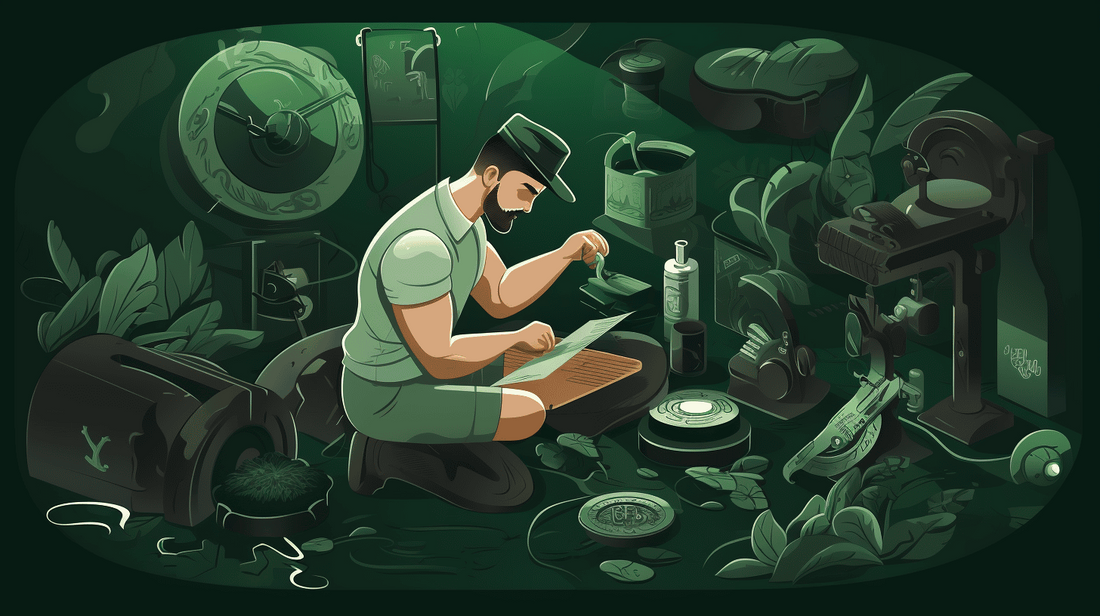The timeless ritual of shaving has been an integral part of our grooming routine for centuries. Over the years, the tools and techniques used have evolved dramatically, reflecting the advancements of technology and shifting cultural norms. Shaving, initially considered a basic routine task, has now transformed into a realm where tradition can happily coexist with modernity.
From the first use of seashells in prehistoric times to straight razors in the 17th century, and now the current generation's fondness for electric shavers and trimmers, you can clearly witness an intriguing journey of evolution.
So, are you ready to delve deeper into the world of shaving techniques? Let's explore how an old-world custom has successfully synchronized with the demands of the 21st century seamlessly. In this insightful article, we'll take you on a guided tour through the global and US market trends, analyze current shaving patterns and habits, and understand how different techniques influence shaving efficacy. Additionally, we'll do a comparative study of traditional versus modern shaving methods and take a peek into what the future holds for the industry. Stick around as we unravel the fascinating interplay of tradition and modernity in the world of shaving.
Overview of Global Shaving Market
The global shaving market is a dynamic ecosystem marked by innovative products, emerging consumer preferences, and forecasts promising substantial growth. It encompasses multiple facets, from traditional razors to advanced electric shavers, and incorporates significant players in the cosmetic and personal care industries. This vibrant market, teeming with variety, intrigue, and potential, is a mirror to changing consumer behaviors, technological innovations, and evolving market trends.Overview of US Shaving Market
The US Shaving market is a vibrant and evolving industry, characterized by continuous shifts in consumer preferences and emerging market trends. This sector has come a long way from the traditional straight razors to innovative safety razors, grooming kits, and an increasing demand for natural shaving products.
Current Market Size
In 2021, the market size of the U.S razor industry was a massive $2753.4 million. This significant figure is indicative of the market's underlying potential and the consumer's inclination towards grooming and personal care products. The expansive range of products offered, coupled with the rising emphasis on personal hygiene, has played a crucial role in shaping the current market size.
Projected Growth and Market Size
Looking into the future, the US shaving market is projected to grow at a CAGR of 0.96% from 2021 to 2030. While this growth rate might seem moderate, in terms of actual market value, it translates to substantial growth over the next decade. This growth projection stems from a combination of factors such as increasing awareness regarding personal grooming, evolving consumer preferences, and the influx of innovative and personalized products.
Demand for Natural Shaving Products
A notable trend that deserves special mention in the US shaving market is the increasing demand for natural shaving products. Consumers are becoming more conscious about the products they use, their ingredients, and their impact on the environment. As a result, natural shaving products, free from harmful chemicals and embedded with the goodness of nature, have seen a steady rise in demand.
Consumer Trends
Keeping in line with the evolving market dynamics, consumer trends in the US shaving market have seen significant shifts. Today's consumers are proactively seeking products that cater to their specific needs, be it a close and smooth shave, sensitive skin products, or environmentally sustainable choices. Moreover, the advent of subscription-based services and direct-to-consumer brands in this space has further revolutionized how consumers purchase and engage with shaving products.
Presenting a picture of continuous advancement, the US shaving market is certainly a space to watch out for in the coming years. With new trends and consumer preferences emerging, the market is poised for further evolution and expansion.
Current Shaving Patterns and Habits
In exploring the wide universe of personal grooming, an enormous portion is undoubtedly committed to the art of shaving. This simple, often daily routine, is more than just an aesthetic choice; it's a deeply ingrained ritual in many cultures, spanning across decades and centuries. As we delve into the current shaving patterns and habits, we uncover intriguing details of frequency, duration, equipment selection, and shifting trends brought on by social and cultural transformation.
Frequency of Shaving
When it comes to how often people shave, interesting variations exist between genders and across different age groups. Astonishingly, research indicates that over 90% of all adult males shave at least once a day. This translates to at least 20,000 shaving sessions spanning across their lifetime—a testament to the integral role shaving plays in their grooming routines.
Duration of Shaving Sessions
If you've ever wondered how long the average person spends shaving, you may be in for a surprise. The average shaving session clocks in at around 10.9 minutes. This seemingly mundane activity accounts for a significant part of many people's daily routines. Studies suggest that a more relaxed, time-consuming session can be more therapeutic and potentially beneficial to our skin's health.
Choice of Shaving Equipment
The tools employed in this grooming activity largely depend on personal preference, skin suitability, and economic feasibility. Among the myriad options available, disposable razors are by far the reigning champion around the globe. In a startling revelation, global consumption of disposable razors hits approximately a staggering 5,000 billion per year. This staggering figure underscores the sheer or universal popularity and highly disposable nature of these tools.
Evolution of Shaving Habits
Over time, shaving habits shift and evolve amidst fluctuating trends, societal norms, and emerging research. A growing trend among women highlights this evolution impressively: more than 80% of women today regularly groom their pubic hair—a practice that was less prevalent or discussed a few decades ago. This represents a broader shift in societal attitudes towards body hair, influenced by evolving beauty standards, sexual health conversations, and individual comfort.
As we scrutinize these patterns through the subheadings, it becomes clear how engrained shaving habits are in individuals' lifestyle. Understanding these variations and trends provides valuable insights for manufacturers, marketers, and individuals alike, catalyzing improvements in products, marketing strategies, and personal grooming routines. Undoubtedly, the journey through the landscape of current shaving patterns and habits promises exciting exploration and important opportunities.
The Influence of Shaving Techniques on Efficacy
The art of shaving is not just about the number of blades on your razor. In fact, the efficacy of shaving relies more heavily on your technique. With the right approach, you can achieve a close and smooth shave, regardless of how many blades you're using. The journey to master the right technique may seem challenging but fear not, as we're here to decode some shaving mysteries and guide you towards achieving that perfect shave.
Number of Blades Versus Technique
It's undeniable that more blades on a razor can pave the way for a closer shave. They glide across your skin, slicing through the hair close to the root. This results in a smoother feel and reduces the number of strokes you need, which can greatly minimize the chance of razor burn or irritation.
However, even the fanciest multi-blade razors can't compete with a well-executed shaving technique.
You don't just drag the razor across your skin. Take your time and pay attention to the direction in which your hair grows. Shave with the grain — in the direction of hair growth — first, then against the grain for a closer shave. Take note to rinse the razor after every few strokes.
Enhancing the Shaving Experience
While techniques and blades play key roles in achieving an outstanding shave, using additional products can further enhance your experience. For instance, the use of pre-shave lotions prepares your skin for a shave by softening the hair, while giving lubrication for the blade to glide effortlessly. On this note, feel free to explore our Pre Shave Tips for a comprehensive guide.
Another crucial step is stretching the skin. It serves two purposes: to protect the skin from wounds and to provide a close shave, as flat skin allows the blade to cut the hair closer to its base. Lastly, choosing the right shaving gel or cream isn't just about the scent—it should provide enough cushion and glide to minimize friction.
The quest for the perfect shave doesn't rely on a single factor. Technique, choice of blades, and the use of additional products all work in tandem to yield the best outcome. Remember, practice makes progress. So arm yourself with these tips, and you'll see improvements over time.
Traditional Versus Modern Shaving Techniques
In recent years, we've observed a fascinating shift in the world of personal grooming. Even as technology carries grooming practices forward with modern electric shavers and trimmers, a certain demographic is spiritedly gravitating back to the age-old tradition of wet shaving with straight razors and safety razors. Both methods have their merits, and both continue to carve a niche in the field of personal care. So, let's take a closer look at these different perspectives on one age-old task, each with its unique set of benefits and techniques.
Electric Shavers and Trimmers
At the forefront of modern shaving methods, electric shavers and trimmers have steadily grown in popularity. Their chief appeal lies in their convenience and precision.
- Speed: With electric shavers, you can achieve a clean shave or a neat trim in a fraction of the time it takes with traditional shaving methods.
- Versatility: Many electric devices offer multi-functionality, allowing you to trim, edge and detail your beard to achieve an array of styles.
- Safety: With protective guards and adjustable settings, the risk of nicking your skin is significantly reduced with electric shavers.
Safety Razors
Despite the rise in electric shavers, many people have retained or returned to the wet shaving method using safety razors. Besides the undeniably classy feel, they offer several benefits that contribute to their popularity:
- Cost-effective: A safety razor may appear costly initially; however, the recurring costs are substantially lesser, making it a cost-effective option over time.
- Superior Shave: Due to the single-blade use, safety razors are known to offer a closer and smoother shave compared to their electric counterparts.
- Environmental-friendly: Unlike disposable razors, safety razors have reusable metal parts and only require changing the blade regularly, making them a more eco-friendly option.
Straight Razors
Straight razor shaving is not just about grooming; it's a cherished ritual. Just like fine wine, its appeal has only got better with age. Its resurgence allows for precision and expertise that often only come through professional barber services:
- Artistry: Straight razor shaving is seen as an art. It requires significant skill, making it an immersive and satisfying experience.
- Closest Shave: Owing to the sharp, unhindered blade, straight razors supposedly give the closest shave possible.
- Durability: A well-maintained straight razor can last a lifetime, literally. This long-term durability adds to their cost-effectiveness and eco-friendliness.
The opposing worlds of traditional wet shaving and modern shaving methods champion different virtues, each catering to varied preferences and needs. As these trends continue to ebb, flow, and even overlay, it's evident that neither practice will be bowing out soon. For those enticed by the return to traditional methods, explore our blog about the Comeback of Traditional Techniques for a more in-depth look into the appeal and practices of wet shaving.
Future of Shaving Industry
The future is already here, and it's redefining aspects of life we never thought would change - such as the simple act of shaving. The shaving industry is undergoing a significant makeover, spurred by a blend of tech advancements, sustainable initiatives, and societal norms’ impact.
Challenges to Societal Norms
The days of the shaving industry targeting a strictly male dominant audience are disappearing rapidly within the rearview mirror. Today, the industry is in a transformative phase, challenging the conventional gender-based societal norms that have long ruled over it.
Over the past few years, we've noticed an increase in inclusivity in the advertising and marketing of shaving products. Brands are breaking away from the 'men-only' narrative, recognizing that women are robust market players - not to mention the acknowledgement and inclusion of nonbinary and gender nonconforming individuals. Shaving isn't just for the boys anymore; it's for everyone who seeks smooth, hair-free skin.
In many ways, the shaving industry has transcended from being solely about removal of facial hair to becoming a crucial part of individuals’ self-care. The industry is embracing diversity and displaying a keen understanding of the fluidity of gender. What was once perceived as a largely male-focused industry is now targeting a broader audience, making space for all who seek top-notch grooming experiences.
Rise in Sustainability and Premium Materials
Another seismic shift in shaving is the industry's growing fondness for sustainability and premium materials. Does a superior grooming experience come at the cost of the environment nowadays? Not anymore! The shaving industry is fiercely concentrating efforts toward innovation and sustainability, finding plant-based and biodegradable alternatives for the production of razors and shaving creams.
Say goodbye to plastic handles and hello to razors curated from bamboo, metal, or recycled materials. The industry's move toward biodegradable and premium materials is fueled by consumers' growing environmental consciousness.
Furthermore, a superior grooming experience no longer just implies a clean, close shave. It could mean a bamboo razor with a titanium-coated blade for a cut above the ordinary, or perhaps a shaving cream infused with rejuvenating essential oils. The age-old shaving routine is now a luxurious affair, enveloped in the aura of self-care.
As we edge into the future, the shaving industry is evolving, focusing on inclusivity, sustainability, and offering extraordinarily delightful experiences with premium materials. The future of shaving is no longer just about removing hair; it's about respect for the planet and self-expression in grooming and skincare régimes. The stage is set for remarkable innovations that will continue to redefine the shaving experience.
Conclusion
As we move toward the future of shaving, it's clear that both tradition and innovation play significant roles. Shaving isn't merely a daily or weekly ritual; it's a personal experience that blends practicality with user experience. Whether it's the rise of sustainability considerations, the demand for premium materials, or the enduring appeal of traditional techniques, the shaving industry appears set to continue its evolution.
What remains constant however, is the universal need for quality care before, during, and after a shave. At Bart's Balm, we're committed to delivering high-quality, handmade products that enhance your shaving experience and keep your skin in absolute peak condition. From our pre-shave balms that prepare your skin for a smooth shave, to our aftershave balms that soothe and protect your skin post-shave—all accompanied by our enchanting Eau De Parfums, we have you covered. Visit our store and discover the difference of a truly elevated shaving experience.
Embrace the future, but don't forget tradition. Your shaving routine deserves the best of both worlds.
Frequently Asked Questions
-
What are some traditional shaving techniques that are still popular today?
Some traditional shaving techniques that are still popular today include straight razor shaving, safety razor shaving, and wet shaving with a brush and shaving cream or soap.
-
What are the benefits of traditional shaving techniques?
Traditional shaving techniques provide a closer shave, reduce skin irritation and ingrown hairs, save money in the long run, and offer a more relaxing and luxurious shaving experience.
-
Can women also use traditional shaving techniques?
Yes, women can also use traditional shaving techniques. Many women prefer using safety razors or straight razors for a closer and more precise shave, especially for areas like legs and underarms.
-
Are there any modern advancements in shaving techniques?
Yes, there have been modern advancements in shaving techniques. Some of these include electric shavers with advanced technology, multi-blade cartridge razors, and the use of pre-shave oils and aftershave balms to enhance the shaving experience.
-
What are some tips for achieving the best shave with traditional techniques?
Some tips for achieving the best shave with traditional techniques include preparing the skin with warm water or a hot towel, exfoliating before shaving, using a sharp and clean razor, using a proper shaving cream or soap, and moisturizing the skin afterwards.






